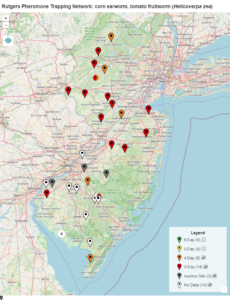Sweet Corn
Fall armyworm (FAW) infestations continue in most scouted locations in central and northern NJ counties. There are pockets of heavier pressure, such as on the Burlington/Camden County border area. Re-infestations following treatment can and have occurred. Because FAW moths are highly mobile, it is important to monitor fields at least weekly for signs of infestation. Whorl, and even seedling stage plants are prime targets for egg laying. Delays in treating whorl stage infestations can lead to stunted plants and poor ear size.
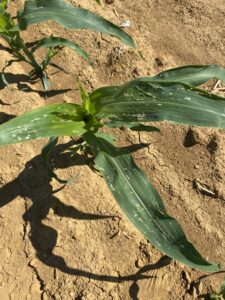 Newly hatched FAW larvae cause holes and scratches on leaves that are similar to ECB feeding, except that they tend to be more concentrated and always lead down into the whorl (see photo at upper left). As the larvae grow, the feeding becomes more destructive, with large ragged holes and obvious droppings deposited in the whorl (see photo at right).
Newly hatched FAW larvae cause holes and scratches on leaves that are similar to ECB feeding, except that they tend to be more concentrated and always lead down into the whorl (see photo at upper left). As the larvae grow, the feeding becomes more destructive, with large ragged holes and obvious droppings deposited in the whorl (see photo at right). 
We will provide updates on new FAW appearances and severity as reports come in. FAW are resistant to synthetic pyrethroids. Effective sprays should include IRAC grp. 5 (spinosyns) or IRAC grp. 28 (diamides). The carbamate (IRAC grp. 1A) Lannate is also still effective. Sufficient water should be used 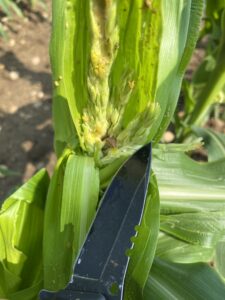 in the applications to allow the solution to reach larvae that are partially protected while feeding on the immature tassel (photo at lower left), and to penetrate the layer of droppings that may have formed above the caterpillars.
in the applications to allow the solution to reach larvae that are partially protected while feeding on the immature tassel (photo at lower left), and to penetrate the layer of droppings that may have formed above the caterpillars.
Corn earworm (CEW) moths captures from northern and central blacklight traps have remained stable at fairly high levels. Pheromone trap information is available from all northern and central sites, but is limited from southern New Jersey. Overall, pheromone catches are also steady, with high catches being recorded. Woodstown (Salem) has the highest catches that we know of, while locations in Burlington, Camden and Somerset counties all had big numbers this week (see pheromone trap map below). Cooler night time temperatures this week will likely suppress CEW trap catches, but we should expect a rebound when warmer weather returns by the end of the week. We will use a combination of pheromone and blacklight trap types to derive silk spray schedules by region. Silking corn is at risk of CEW infestation at this time. Be sure to access information from this publication in the upcoming weeks to determine how frequently you should treat silking sweet corn to protect it from CEW infestation.
The highest nightly blacklight trap catches of CEW for the week ending 8/21/24 are as follows:
| Georgetown 7 | Farmingdale 3 | Denville 2 | Milltown 1 |
| Bellemeade 5 | Morristown 3 | Matawan 2 | Sergeantsville 1 |
| Lawrenceville 4 | Old Bridge 3 | New Egypt 2 | Pennington 1 |
The highest nightly pheromone trap catches of CEW for the week ending 8/21/24 are as follows:
| Woodstown 112 | South Branch 52 | Farmingdale 40 |
| Georgetown 58 | Milford 50 | Bellemeade 37 |
| Elm 56 | Pennington 50 | Hackettstown 33 |
| New Egypt 56 | Matawan 48 | Allamuchy 31 |
Thanks to Joe LaForest of Univ. of GA, and the Southern IPM Center for producing maps from our NJ CEW data!
Using our current pheromone- based thresholds (30″ Hartstack trap) developed by the Univ. of Delaware, nightly corn earworm moth catches translate to:
0 moths – 6-7 day spray schedule
1 moth – 5 day spray schedule
2-20 moths – 4 day spray schedule
>20 moths – 3 day spray schedule
Silking Spray Schedules*:
South – 3 days
Central – 3 days
North – 3 days
*These recommendations are based on regional catches. Adhere to tighter spray schedules if indicated by local trap catches. Synthetic pyrethroids alone should NOT be used for corn earworm (CEW) protection on silking corn, or for fall armyworm (FAW) management at any stage. Control with these materials is very inconsistent.
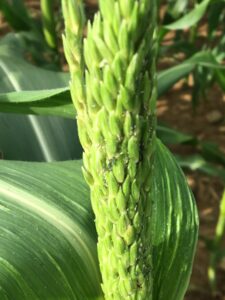 Field scouts are finding corn leaf aphid (photo at left) in almost every planting of pre-tassel and tassel stage sweet corn. This pest can build to very high numbers on plants, and with repeated use of pyrethroid insecticides, can become a contaminant as it infests corn ear husks. If aphids are detected in tassels just prior to silking, consider adding the neonicotinoid acetamiprid (Assail, Anarchy) to the regular silk spray material(s). Methomyl (Lannate) is also useful at limiting aphid populations.
Field scouts are finding corn leaf aphid (photo at left) in almost every planting of pre-tassel and tassel stage sweet corn. This pest can build to very high numbers on plants, and with repeated use of pyrethroid insecticides, can become a contaminant as it infests corn ear husks. If aphids are detected in tassels just prior to silking, consider adding the neonicotinoid acetamiprid (Assail, Anarchy) to the regular silk spray material(s). Methomyl (Lannate) is also useful at limiting aphid populations.
Tomatoes
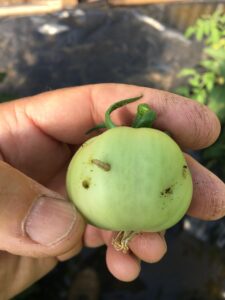
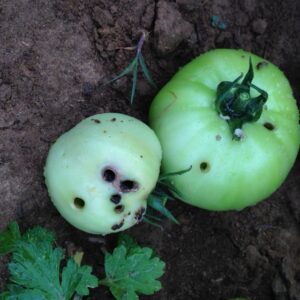 With dramatic increases in CEW (aka. tomato fruitworm) moth numbers, it is important to monitor fields for the appearance of injury in tomato plantings. The CEW moth often lays eggs near flower clusters near the upper canopy of plants, resulting in larval damage to green fruit in very visible areas (see photos at left). Larvae typically enter the shoulders of fruit, and may move around, causing injury to multiple fruit. Local pheromone trap catches approaching 20+ CEW per night may warrant preventive sprays for this pest. At minimum, growers should be checking fields for the presence of fruitworm injury. Just as with CEW in sweet corn, effective materials in tomatoes include IRAC 5 (spinosyns) and IRAC 28 (diamides). See the Tomato Section from the 2024-25 Guide for a complete list.
With dramatic increases in CEW (aka. tomato fruitworm) moth numbers, it is important to monitor fields for the appearance of injury in tomato plantings. The CEW moth often lays eggs near flower clusters near the upper canopy of plants, resulting in larval damage to green fruit in very visible areas (see photos at left). Larvae typically enter the shoulders of fruit, and may move around, causing injury to multiple fruit. Local pheromone trap catches approaching 20+ CEW per night may warrant preventive sprays for this pest. At minimum, growers should be checking fields for the presence of fruitworm injury. Just as with CEW in sweet corn, effective materials in tomatoes include IRAC 5 (spinosyns) and IRAC 28 (diamides). See the Tomato Section from the 2024-25 Guide for a complete list.
Beet Armyworm
Beet armyworm (BAW) numbers in pheromone traps in the Woodstown area of Salem County have gotten extremely high over the past week. Thanks to a grower cooperator in that area, we know that catches are 219/night over the past week in local traps. This pest can cause significant injury on peppers as well as leafy greens like swiss chard, and kale. Larvae are beginning to appear as far north as Hunterdon County, although it is likely that serious infestations are or will occur in southern NJ now. Monitor pepper fields weekly for signs of feeding. BAW larvae (photo at left) feed in the developing foliage in terminal growth of pepper plants. Initially, leaves are skeletonized, but as larvae grow, they will move onto fruit and damage these as well. 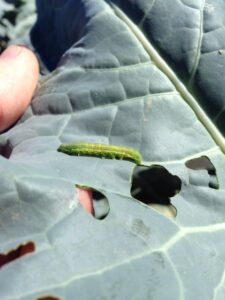 In northern NJ, BAW is an occasional, and typically low level pest of cole crops. Infestations tend to be very local for unknown reasons. As with other armyworms, BAW is difficult to control with pyrethroid insecticides. Effective materials include spinosyns (IRAC 5) and diamides (IRAC 28).
In northern NJ, BAW is an occasional, and typically low level pest of cole crops. Infestations tend to be very local for unknown reasons. As with other armyworms, BAW is difficult to control with pyrethroid insecticides. Effective materials include spinosyns (IRAC 5) and diamides (IRAC 28).
Cucurbit Crops
Cucurbit downy mildew (CDM) is active on many cucurbit crops throughout NJ now. Look for chlorotic areas bordered by veins on the upper leaf surface (photo at lower right). If conditions are moist, dark sporulation may be found on the lower leaf surface (photo at lower left). CDM has been identified on winter squash in northern NJ as of 8/18/24 (see CDM update) and on pumpkin and summer squash in southern NJ as of 8/21/24 as Dr. Andy Wyenandt reports today.
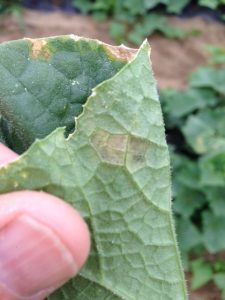
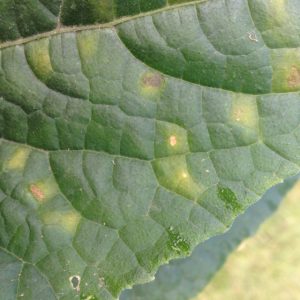 All cucurbit plantings should be protected now. Useful materials for CDM may be found in the Cucumber Section of the 2024/25 Commercial Vegetable Production Recommendations.
All cucurbit plantings should be protected now. Useful materials for CDM may be found in the Cucumber Section of the 2024/25 Commercial Vegetable Production Recommendations.
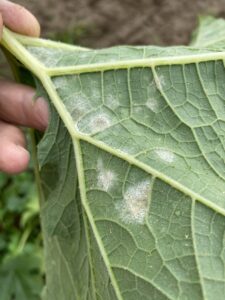 Powdery mildew (PM) thresholds (2 infected leaves/50 leaf sample) is now present in all fields. Once PM lesions (photo at right) begin to appear, the protectant fungicide program for this disease should be initiated. The program generally includes a combination of broad spectrum protectants and more targeted, locally systemic fungicides. For a complete list of suggested materials, see the Pumpkin and Winter Squash Section of the 2024/25 Commercial Vegetable Production Recommendations. Ideally, a fungicide program should include a rotation of 3 different FRAC code materials combined with broad spectrum protectants in each application.
Powdery mildew (PM) thresholds (2 infected leaves/50 leaf sample) is now present in all fields. Once PM lesions (photo at right) begin to appear, the protectant fungicide program for this disease should be initiated. The program generally includes a combination of broad spectrum protectants and more targeted, locally systemic fungicides. For a complete list of suggested materials, see the Pumpkin and Winter Squash Section of the 2024/25 Commercial Vegetable Production Recommendations. Ideally, a fungicide program should include a rotation of 3 different FRAC code materials combined with broad spectrum protectants in each application.
Cole Crops
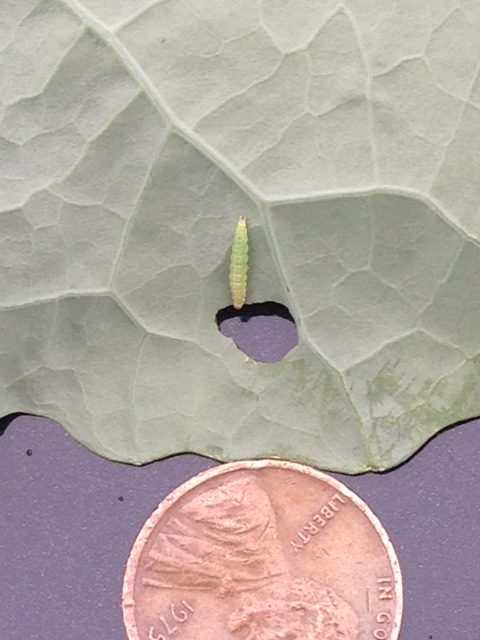 With fall plantings now establishing, it is typical for diamondback moth larvae ((DBM) see photo at right) to become the dominant caterpillar pest in many cole crop fields. This pest can multiply quickly, with a generation completed in under 2 weeks with high temperatures. Furthermore, this pest is not responding to chlorantraniliprole (Coragen) in many parts of the state. Effective materials continue to be IRAC 5 materials (spinosyns), and the IRAC 6 material, ememectin benzoate (Proclaim). Be sure to check the Cole Crops Section of the 2024-25 Commercial Guide for specifics, as PHI’s and crop labels vary. It is important to return to treated fields within 2-3 days to assess the efficacy of the insecticide applications. Effective materials should eliminate DBM larvae within 48 hours.
With fall plantings now establishing, it is typical for diamondback moth larvae ((DBM) see photo at right) to become the dominant caterpillar pest in many cole crop fields. This pest can multiply quickly, with a generation completed in under 2 weeks with high temperatures. Furthermore, this pest is not responding to chlorantraniliprole (Coragen) in many parts of the state. Effective materials continue to be IRAC 5 materials (spinosyns), and the IRAC 6 material, ememectin benzoate (Proclaim). Be sure to check the Cole Crops Section of the 2024-25 Commercial Guide for specifics, as PHI’s and crop labels vary. It is important to return to treated fields within 2-3 days to assess the efficacy of the insecticide applications. Effective materials should eliminate DBM larvae within 48 hours.
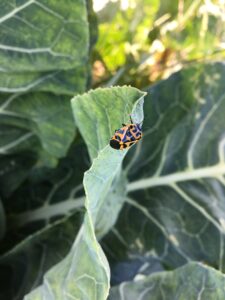 Harlequin bugs (photo at left) seem to be more prevalent in cole crop fields this year. This colorful stink bug will cause a cloudy spot-like injury on leaves of all brassica plants. This injury is particularly problematic on leafy greens like collards and kale.
Harlequin bugs (photo at left) seem to be more prevalent in cole crop fields this year. This colorful stink bug will cause a cloudy spot-like injury on leaves of all brassica plants. This injury is particularly problematic on leafy greens like collards and kale. 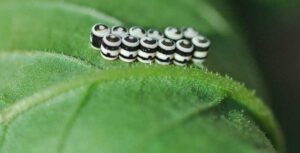 While scouting, note the presence of adults, eggmasses (photo at right, by Mike Raupp of U of Md) and injury to plants. If bugs are active in more than one site in a ten site sample, consider applying an insecticide. For conventional insecticide recommendations, see the Cole Crops section of the 2024-25 Commercial Vegetable Guide. Organic options are limited to pyrethrum products. Mechanical barriers, like row covers, may help limit injury.
While scouting, note the presence of adults, eggmasses (photo at right, by Mike Raupp of U of Md) and injury to plants. If bugs are active in more than one site in a ten site sample, consider applying an insecticide. For conventional insecticide recommendations, see the Cole Crops section of the 2024-25 Commercial Vegetable Guide. Organic options are limited to pyrethrum products. Mechanical barriers, like row covers, may help limit injury.
Corn Earworm Traps – 30″ Hartstack type
Growers wishing to purchase corn earworm pheromone traps to conduct their own on-farm monitoring should contact:
Mike “O” Olsowski
3510 Sutton Rd.
Geneva, NY 14456
Phone: 315-651-5929
Mike O manufactures these 30″ Hartstack traps in his shop. These traps are the same as the ones we use currently in the IPM Program, and spray thresholds are based on this type.
Lures currently used in the Rutgers Vegetable IPM Program corn earworm pheromone traps are:
Hercon Luretape, available from Great Lakes IPM
Lures are placed in the clip at the base of the large cone, and a new one is added at two week intervals.
Thank you!
The Vegetable IPM Program wishes to thank the following Field Technicians, without whom much of the information presented weekly here would not be available:
Chris Cloutier
Hamna Khalid
Alexandra Suszko
